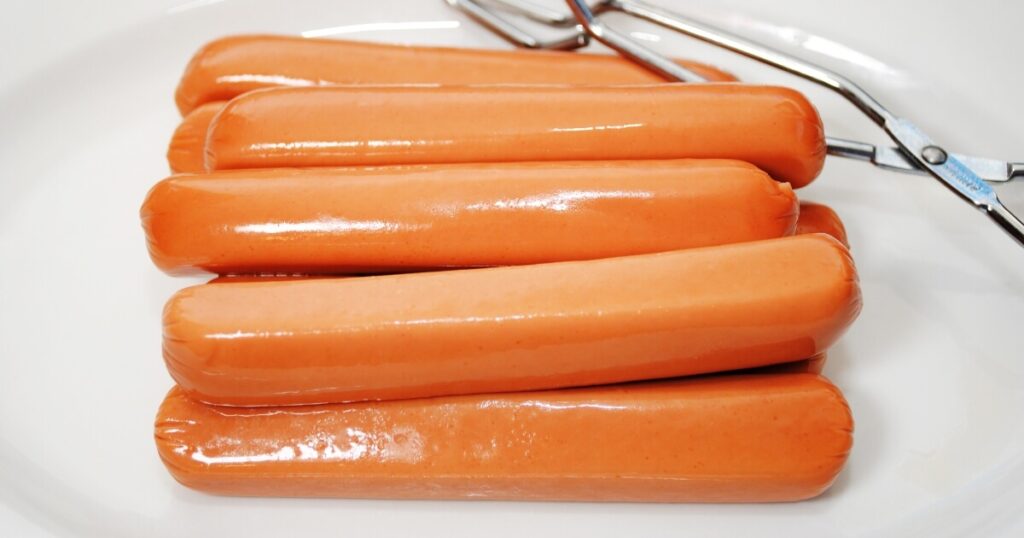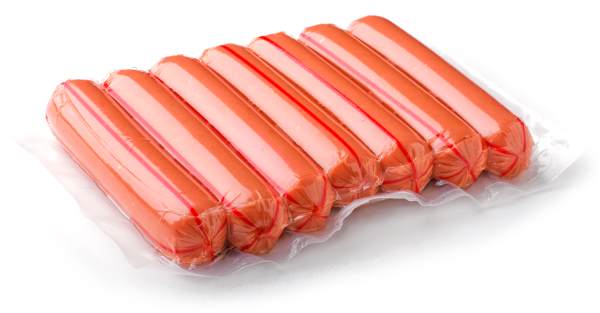Hot dogs are an iconic American food eaten everywhere, from ballgames to backyard barbecues. Because they come pre-cooked and contain many preservatives, you might assume they have a long shelf life.
But how long do hot dogs last?

Hot dogs last up to 2 weeks in the fridge unopened, 1 week once opened, and 3-4 days when cooked. In the freezer, they’re best consumed within 1-2 months, though they remain safe indefinitely. Always check the package’s expiration date and store it properly to ensure freshness.
The right storage can be the difference between a juicy, flavorful bite and a disappointing one that makes you sick. So, let’s get into the details of their shelf life so that your hot dogs are always on point!
Hot Dog Shelf Life: How Long Do They Last?
For a quick glance at the shelf life of hot dogs in various conditions, check out the table below.
| Storage Condition | Unopened Package | Opened Package | Cooked Hot Dogs |
|---|---|---|---|
| Refrigerator (Fridge) | 2 weeks | 1 week | 3-4 days |
| Room Temperature (Unadvised) | 1-2 hours | 1 hour | 1 hour |
| Freezer | 3 months | 1 month | 1 month |
If your hot dog’s original package has a Use-By date, the USDA recommends sticking to that date. On the other hand, a best-by date is a more general guideline, and hot dogs can stay good for up to two weeks beyond that date if stored correctly.
Regardless of whether your pre-cooked hotdogs are made with pork, chicken, beef, or other blended meat products, they all have a similar shelf life.
How Long Can Hot Dogs Sit Out?
Like many perishable foods, hot dogs are vulnerable to bacterial growth when left at room temperature.

This is especially concerning because hot dogs are often pre-cooked, making them a prime target for bacteria that thrive on cooked foods.
The Danger Zone:
The USDA defines the “Danger Zone” as temperatures between 40°F and 140°F. It’s the range where harmful bacteria grow most rapidly. Hot dogs left out in this temperature range can quickly become unsafe to eat.
Bacterial Growth and Listeria:
While many bacteria can grow on food left out, listeria is one of the primary concerns with hot dogs. Listeria is unique because it can still grow, albeit slowly, even in refrigerated conditions. However, at room temperature, its growth rate accelerates.
Consuming spoiled food contaminated with listeria can lead to listeriosis, a serious infection that’s especially dangerous for pregnant women, the elderly, and individuals with weakened immune systems.
General Guidelines for Hot Dogs:
- Normal Room Temperatures (below 90°F): If hot dogs have been left out for more than two hours, it’s best to discard them. In this time frame, bacteria would have multiplied to levels that can be harmful when consumed.
- Hotter Conditions (90°F and above): In warmer conditions, like a hot summer day, the time frame shrinks dramatically. Hot dogs shouldn’t be left out for more than one hour. The higher temperature provides an even more conducive environment for rapid bacterial growth.
Preventive Measures:
- Always try to keep hot dogs refrigerated until you’re ready to cook or serve them.
- If you’re hosting a picnic or outdoor event, consider using ice packs or coolers to keep hot dogs chilled.
- Be mindful of the time when serving hot dogs in outdoor settings, especially during warmer months.
Keeping Your Hot Dogs Fresh
Storing hot dogs properly is the secret sauce to keeping them fresh and tasty.

Let’s get into some top-notch storage tips that’ll make your hot dogs last longer.
- Keep Them Cold: As soon as you get home from the store, pop those hot dogs right into the fridge. This keeps them fresh and slows down any bacterial growth.
- Original Packaging is Key: Keep hot dogs in their original packaging unopened until you’re ready to use them. It’s designed to maintain freshness.
- Seal the Deal: If you’ve opened a pack but won’t use all the hot dogs immediately, transfer the leftovers to a resealable plastic bag or airtight container. This prevents air from getting in and drying them out.
- Avoid the Door: Store hot dogs in the main part of the fridge, not in the door. The temperature is more consistent there, which is better for preservation.
- Freeze with Care: If you’re not going to eat your hot dogs within a week, consider freezing them. Just make sure they’re wrapped tightly to avoid freezer burn.
How To Tell If Hot Dogs Are Bad
Recognizing when hot dogs have gone south is crucial for your health. Here are a few telltale signs that those dogs might be past their prime.
- Slimy Hot Dogs: Have you ever felt a hot dog and thought it was a tad too slimy? That’s your cue. When the outside of hot dogs become slimy, they’ve likely gone bad. No amount of cooking will make them safe to eat.
- Color Changes: Hot dogs should have a clear reddish hue. If they shift to a duller brown or grey, it’s time to think twice before cooking them up.
- Sour Smell: Trust your nose on this one. If you crack open a package and catch any off-putting, sour whiffs, it’s best to toss them out.
- Freezer Burn: Frozen hot dogs can be a bit tricky. Due to their high moisture content, they’re prone to freezer burn. Icy patches on the flesh and skin mean the sausage might be dry and less tasty, though not harmful.
- Milky Liquid: Notice a milky liquid in the hot dog package? It could just be fat, but it might also signal bacterial growth. To play it safe, it’s better to discard them.
What Happens If You Eat A Bad Hot Dog?
Despite their deliciousness, hot dogs can be a breeding ground for bacteria if not stored or cooked properly. Their moist nature, combined with the plastic wrapping, makes them prone to bacterial overgrowth.
Even cold storage can’t always keep listeria at bay, though freezing may halt its growth.
You might experience symptoms like fever, diarrhea, and vomiting if you’ve consumed a bad hot dog. These are signs of food poisoning, and while the chances are low, they shouldn’t be ignored. You should seek medical attention immediately if you’re experiencing them.
Listeriosis, caused by listeria, can be particularly severe. If the bacteria spread through your bloodstream or nervous system, the symptoms can escalate, becoming much more intense.
For some, like pregnant women or those with weakened immune systems, listeria poses an even greater threat. It might be best to avoid eating them, but if they do, they must be extra cautious.
One of the best defenses against these bacteria? Heat. The CDC recommends heating hot dogs to 165°F. Always ensure your hot dogs are cooked, like microwaving or boiling hot dogs, thoroughly before serving, especially if they’re for kids. It’s a simple step that can make all the difference in food safety.











